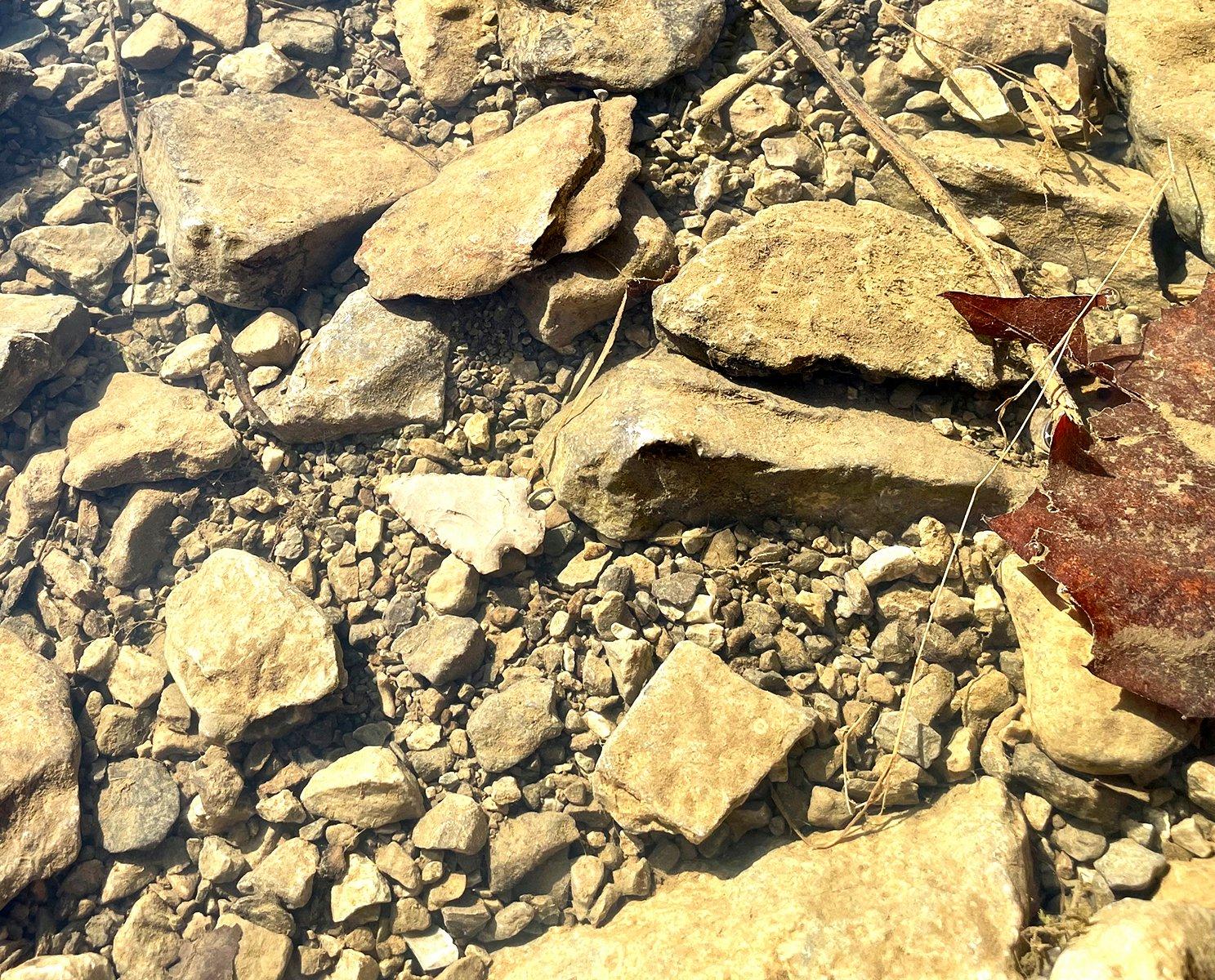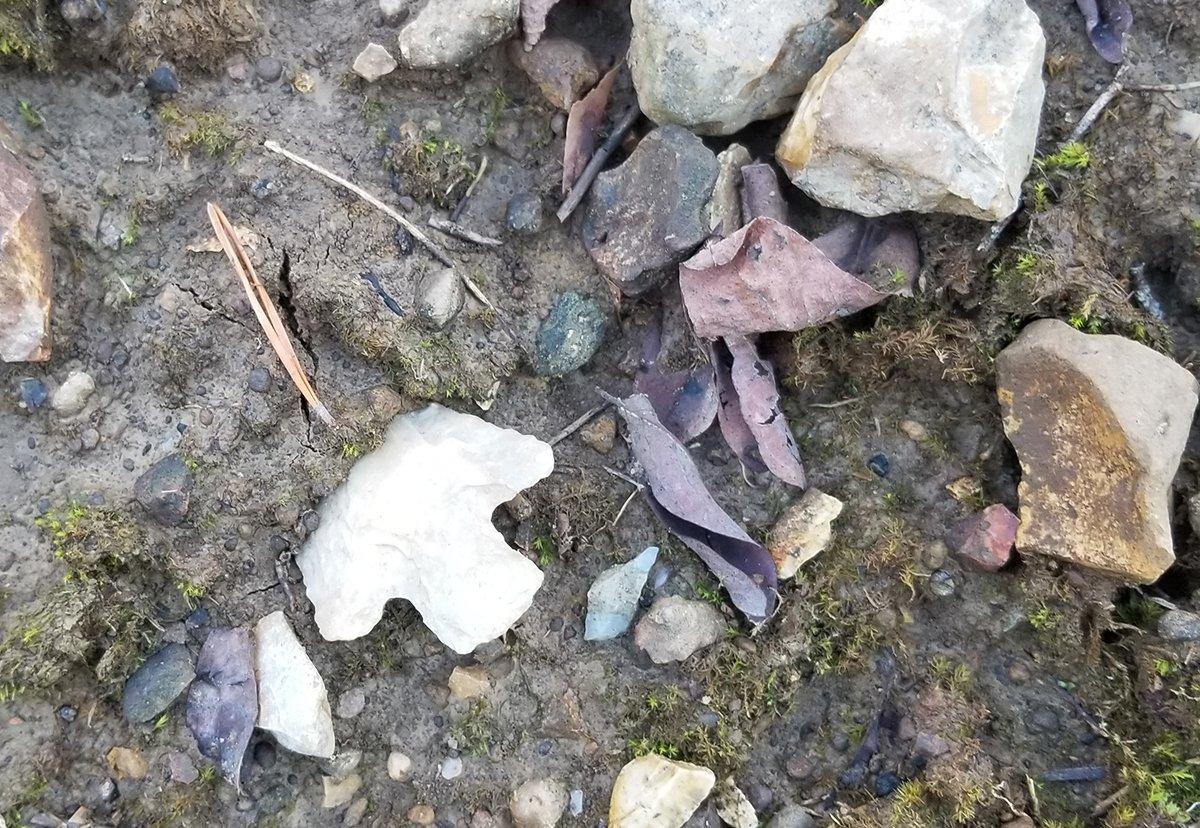Keeping your eyes on the ground can yield evidence of ancient hunters
I wasn't the first hunter who had been there. Even though I was miles from the nearest road, the glint of gray rock shining on the muddy creek bank told me at least one other hunter had walked this valley in the past 13,000 years. It was a stone point, carefully knapped to a razor's edge when hunting gear meant the difference between life and death.
Searching for and collecting Native American artifacts is a popular hobby among folks who love the outdoors. It's a great way to spend the off-season and will help to keep you in shape. Keeping your eyes on the ground while you're hunting will often turn up evidence of past civilizations and people who lived and hunted the same ground thousands of years ago.
Getting Started
If searching for artifacts sounds interesting, artifact collector Les Hatton of Kentucky said some reading will help you become a better collector.
I always tell people to read through a good reference book or two to familiarize themselves with the types of artifacts that might be in their area — who made them and how old they may be," he said. "One of the best out there is The Official Overstreet Indian Arrowheads Identification and Price Guide."
Now on its 15th edition, the Overstreet guide is a hands-on reference to arrowhead types, manufacturing, grading, materials and values. The current edition contains 12,000 actual-size photographs covering hundreds of point types, and has information on how to grade, identify and catalog points. The guide covers points found throughout the United States, including Alaska.
(Don't Miss: 15 Ways to Bag More Late Season Small Game)
Where to Look
Travis Hood is on a constant search for artifacts around his Indiana home.
My favorite places to look are plowed fields, high ground around 200 yards from the outer bends of waterways, and along creeks and streams — both on the bottom and on the shore, especially if there are washed-out steep creek banks, he said. I've even had good luck artifact hunting in areas where pigs are pastured because their constant rooting often turns up points.
If I am in a new area, my rule of thumb is to look around and ask myself, 'Where would I live if I were here thousands of years ago?' I'd want nearby access to fresh water, but be high enough and far enough away that my camp wouldn't wash away in a flood or have constant standing water on the ground. The neat part about finding a good spot where a village once stood is that you might find artifacts from a civilization as current as a thousand years ago and some from as old as 10,000 years ago just feet from each other. Man's basic needs didn't change that much over 15,000 years, and a good spot to live is a good spot to live.
Hood and Hatton said old fire pits, often still visible as dark rings of charcoal and carbon in otherwise light-colored soil, are excellent places to find points and other artifacts.
The campfire is where they spent their time and where they did most of their point knapping, Hood said.
What to Look For
You know you're in a good spot if you start finding small flakes of flint scattered around, especially if flint isn't common in the area.
Once I start noticing flint flakes, called debitage, I start looking for whole or partial points," Hood said. "While nearly everyone generally calls any knapped projectile an 'arrowhead,' most of the stuff you find was probably something else. It could be an ax or celt, a digging hoe, a blade, scraping tool or even a drill. Sure, they made arrowheads, but before bows were commonly used, they made atlatl points and lots of other tools. Some of the earliest stone tools were crude stone blades from the Clovis culture — made by people that lived in the desert Southwest between 11,000 and 13,000 years ago."
Hatton said aging points gets easier with experience, but referencing guide books will help you figure out who made it and when. You might think the more intricate and detailed the point, the more modern it is, but that isn't always the case.
It's interesting, Hood said. Points and tools like those from the Clovis period started out crude and on the large side. Over time, new techniques and experience allowed the tool makers to turn out finer and more intricate points. What's fascinating to me is that the finest points come from the middle period of stone tool making. Up until around 8,000 to 10,000 years ago, points were crude. Then, from 8,000 up to about 2,000 years ago, they got increasingly finer and more advanced. Then, starting a couple of thousand years ago, they regressed into cruder, less finished points. Maybe they were mass producing these points by then and needed to turn out a more disposable, quickly made point or something.
Besides stone tools and points, you might also find whole or pieces of stone pottery or beads, as well as bone tools, jewelry, clay pipes and other remnants of everyday life. If you are lucky enough to find something like that, keep looking. You are probably near a village or long-term camping spot, and there will likely be more artifacts in the area.
You Found Something, Now What?
So you went out looking and found a point. Now what? Hatton recommended taking a bit of time to record some details, especially if it's a whole tool or point, or possibly a really valuable artifact.
Snap a quick photo of the artifact on the ground before you pick it up," he said. "Note where the artifact was found, how deep in the soil and the coordinates or at least a nearby street address. All of this information will be helpful for you to figure out when and by whom the artifact was made, and having as much historical information, known as provenance, with your find as possible might make it more valuable as a collectable."
Plus, keeping information on find locations will act as a guide for future searches.
Cleaning and Storage
When you locate a point or other artifact, what do you do with it?
The first thing to do is leave it alone, Hatton said. You can use a soft brush or toothbrush to remove loose soil from the point, but don't get too rough with it, and don't scrub it clean with soap and water or any other solvents. When experts look at a point under a magnifying glass or microscope, they are looking for certain mineral or soil deposits that help to verify the age. If those deposits are gone, it gets a lot harder to certify that a point is the real thing.
Although avid collectors might have buckets full of partial, unfinished or broken points, Hatton said whole points or anything else that might be valuable need to be stored carefully.
When you toss a stone point into a bucket with other points, they beat against one another to the point that they can chip or break, destroying their value," he said. "The best way to store them is in a flat display case that you can set on a shelf or hang on a wall, or in flat boxes with layers of paper or cloth between the points to prevent them from touching one another.
Some of these points can be extremely valuable. I've personally witnessed one sell for $45,000, and I know of another rare Clovis point right now that is valued at over $100,000. You might find something that is worth a lot of money to the right collector, so treat them gently until you can have them looked at by an expert if you think you have something that might be valuable. That's another area where the reference books come in handy. By comparing size, shape, flaking style, material and notch methods from your point to the reference books, you can get a pretty good idea how much a point is worth and whether or not you should get it appraised.
Keep it Legal
Before you head out to find your own artifacts, Hood and Hatton recommend familiarizing yourself with state and federal laws that apply to artifact hunting. As a rule, private lands require only the permission of the landowner to collect artifacts. But depending on the state, there might be exceptions, such as burial sites, caves and even certain deep stone overhangs that might have been used as religious sites.
When it comes to federally owned lands, removal of artifacts is generally not allowed. The Archeological Resources Protection Act of 1979, which protects any item of archeological interest that is more than 100 years old, and Title 36 of the U.S. Code of Federal Regulations, which deals with theft or destruction of public property, state that anyone found digging or removing artifacts from publicly owned lands can face fines, jail time or both.
On your next hunt, glance down at the ground from time to time. Chances are good that the same wildlife trail you're watching has been used for thousands of years. Perhaps another hunter sat in a nearby location, doing the same thing. Maybe he or she left behind a sign that they were there.
















